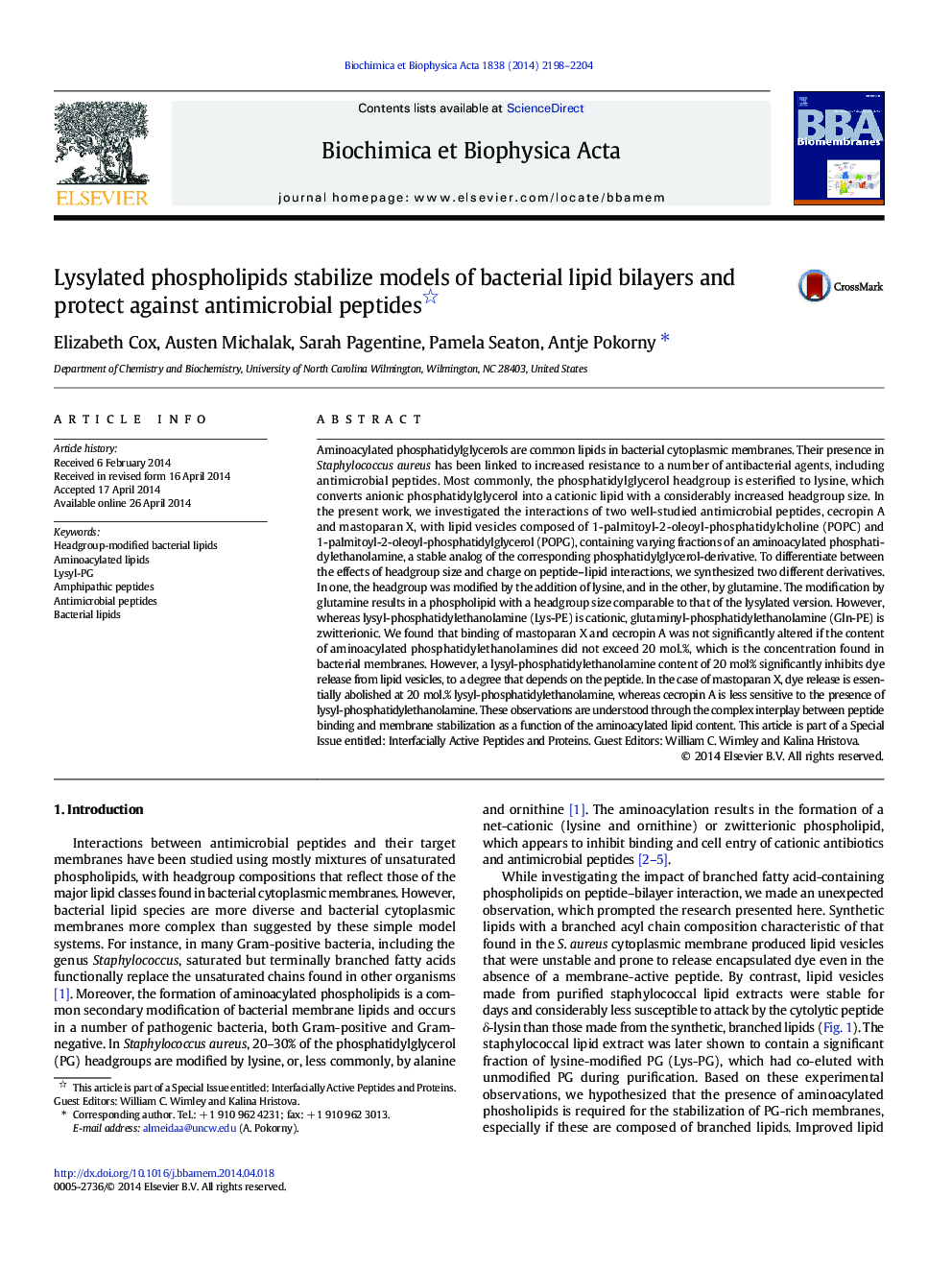| کد مقاله | کد نشریه | سال انتشار | مقاله انگلیسی | نسخه تمام متن |
|---|---|---|---|---|
| 1944177 | 1053188 | 2014 | 7 صفحه PDF | دانلود رایگان |

• Aminoacylation of phospholipid headgroups is common in bacterial membrane lipids.
• Lysylated phosphatidylethanolamines are analogs of lysylated phosphatidylglyerols.
• Lysine-modification of the lipid headgroup stabilizes anionic model membranes.
• Phosphatidylcholine mimics the effects of a lysylated phospholipid.
• The degree of protection afforded by lysylated phospholipids is peptide-dependent.
Aminoacylated phosphatidylglycerols are common lipids in bacterial cytoplasmic membranes. Their presence in Staphylococcus aureus has been linked to increased resistance to a number of antibacterial agents, including antimicrobial peptides. Most commonly, the phosphatidylglycerol headgroup is esterified to lysine, which converts anionic phosphatidylglycerol into a cationic lipid with a considerably increased headgroup size. In the present work, we investigated the interactions of two well-studied antimicrobial peptides, cecropin A and mastoparan X, with lipid vesicles composed of 1-palmitoyl-2-oleoyl-phosphatidylcholine (POPC) and 1-palmitoyl-2-oleoyl-phosphatidylglycerol (POPG), containing varying fractions of an aminoacylated phosphatidylethanolamine, a stable analog of the corresponding phosphatidylglycerol-derivative. To differentiate between the effects of headgroup size and charge on peptide–lipid interactions, we synthesized two different derivatives. In one, the headgroup was modified by the addition of lysine, and in the other, by glutamine. The modification by glutamine results in a phospholipid with a headgroup size comparable to that of the lysylated version. However, whereas lysyl-phosphatidylethanolamine (Lys-PE) is cationic, glutaminyl-phosphatidylethanolamine (Gln-PE) is zwitterionic. We found that binding of mastoparan X and cecropin A was not significantly altered if the content of aminoacylated phosphatidylethanolamines did not exceed 20 mol.%, which is the concentration found in bacterial membranes. However, a lysyl-phosphatidylethanolamine content of 20 mol% significantly inhibits dye release from lipid vesicles, to a degree that depends on the peptide. In the case of mastoparan X, dye release is essentially abolished at 20 mol.% lysyl-phosphatidylethanolamine, whereas cecropin A is less sensitive to the presence of lysyl-phosphatidylethanolamine. These observations are understood through the complex interplay between peptide binding and membrane stabilization as a function of the aminoacylated lipid content. This article is part of a Special Issue entitled: Interfacially Active Peptides and Proteins. Guest Editors: William C. Wimley and Kalina Hristova.
Figure optionsDownload high-quality image (288 K)Download as PowerPoint slide
Journal: Biochimica et Biophysica Acta (BBA) - Biomembranes - Volume 1838, Issue 9, September 2014, Pages 2198–2204